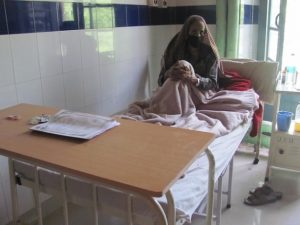Behind Each Climate Disaster Awaits a Tuberculosis Crisis
 13 Oktober 2023
13 Oktober 2023

Tuberculosis remains the leading infectious cause of death in the world, responsible for 1.6 million deaths a year, and is an active and acute crisis in many countries. Credit: Athar Parvaiz/IPS
By Maria Beumont
NEW YORK, Oct 13 2023 (IPS)
At the end of September, two weeks after the United Nations held a High-Level Meeting on Tuberculosis (TB), a torrential storm dropped 6” of rain on New York City. The intensity of the storm recalled that of Hurricane Ida two years earlier, which—in the largest city in the United States—damaged more than 3% of buildings, killed 13 people, and left 380 families homeless.
As recently as the early 1990s, New York City was a hotspot for TB. Throughout the decade, the city spent more than a billion dollars to contain the disease, which had become entrenched in its more impoverished communities—including those without homes. TB has plagued the world for millennia, for as long as communities have been separated by wealth.
If rises in human displacement and hunger are tragic first order effects of climate change, TB is a giant, looming second order effect. Displacement and malnutrition are established risk factors for TB, and both are exacerbated by climate change
Today, it remains the leading infectious cause of death in the world, responsible for 1.6 million deaths a year, and is an active and acute crisis in many countries.
The low-resource settings where much of the world’s TB burden is concentrated are the same places set to bear most of the impact of climate change and whose health systems are ill-equipped to handle added burden.
In August, two typhoons slammed into the coast of Southern China, forcing the evacuation of almost one million people. At the same time, a surprise cyclone hit Southern Brazil, leaving 1,600 people without homes. And earlier this year, Cyclone Freddy hammered Mozambique and Malawi, forcing hundreds of thousands of people into temporary shelter. All four countries have a high burden of TB cases, according to the World Health Organization (WHO).
India, another high-burden TB country, has been hit hard this year by heat waves and drought. It is estimated that 17 million Indians will face climate-change induced hunger by 2030. Increases in climate-induced food insecurity will only add to the existing crisis; the UN estimates that 735 million people around the world faced food shortage in 2022.
If rises in human displacement and hunger are tragic first order effects of climate change, TB is a giant, looming second order effect. Displacement and malnutrition are established risk factors for TB, and both are exacerbated by climate change. Though such impacts are not directly tracked, we can assume that recent climate-enhanced superstorms, heat waves, and droughts amplified the TB burden in Brazil, China, India, Malawi, and Mozambique.
While climate change is a leading topic at major global forums around the world, including at the UN, the TB pandemic remains largely ignored. In 2018, TB appeared on the global radar when the UN held its first High-Level Meeting (HLM) on TB. National delegations agreed to four ambitious goals on providing treatment to people with TB, preventive treatment to people at risk, and drastically increasing the amount of funding devoted to tackling the disease and developing new tools for this effort.
The world was already behind in fulfilling these commitments when the COVID-19 pandemic hit, derailing TB funding and care. As COVID-19 raged, the limited funding and attention for TB had to be diverted to face the new threat. As a result, TB deaths increased for the first time in more than 20 years. Ultimately, not one of the primary commitments from the HLM were met. As climate change intensifies along with the effects of displacement and malnutrition, it may lead to future TB outbreaks and further strain already fragile health systems.
Despite these setbacks, there have been notable achievements in TB research and care. A treatment for the highly drug-resistant forms of the disease was approved by the US FDA and other regulatory authorities, and was endorsed by the WHO. Additionally, the US Centers for Disease Control and Prevention issued guidance on a four-month treatment for drug-sensitive TB, reducing treatment duration for the first time in decades.
TB researchers remain optimistic. Changing the way we fight TB is achievable, and we have a strong research pipeline of promising new TB treatments, diagnostics, and vaccines. Breakthroughs are on the horizon—and they are sorely needed. The impact of safe, shorter, effective, and affordable tools to control TB is anticipated to be significant.
At the UN’s second High-Level Meeting on TB this past September, another batch of ambitious goals were adopted—including a six-fold increase in funding for services and research. During the COVID-19 pandemic, we all witnessed the results of focused efforts and appropriate funds. The same is true for TB: with adequate funding and resources, we can develop the next generation of tools to fight TB. Support from world leaders now is critical, as we can end one of humanity’s oldest diseases if we come together, while also mitigating the impact of one of the climate change crisis. This opportunity cannot be missed.
Excerpt:
Maria Beumont, MD, is Vice President and Chief Medical Officer for the TB Alliance
